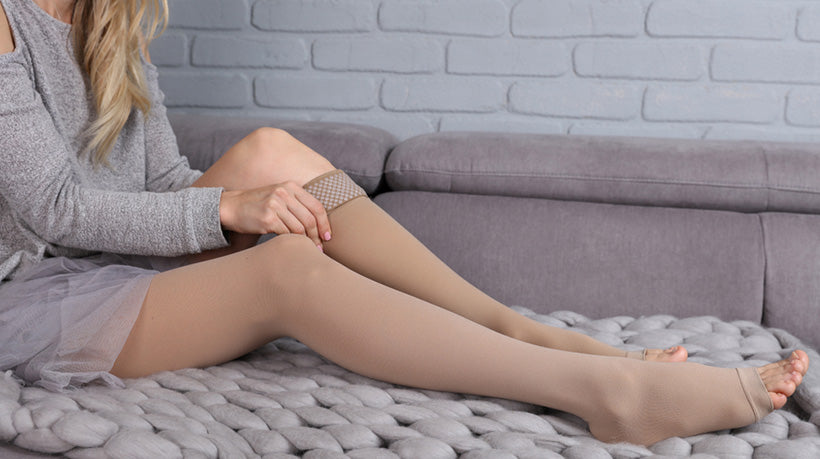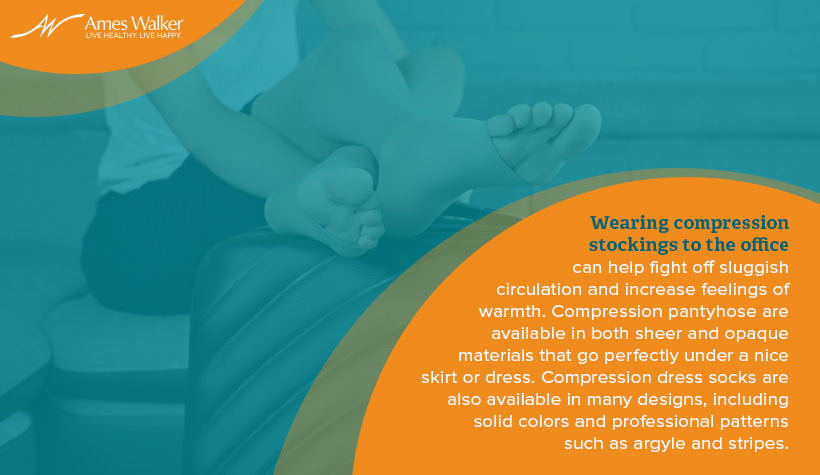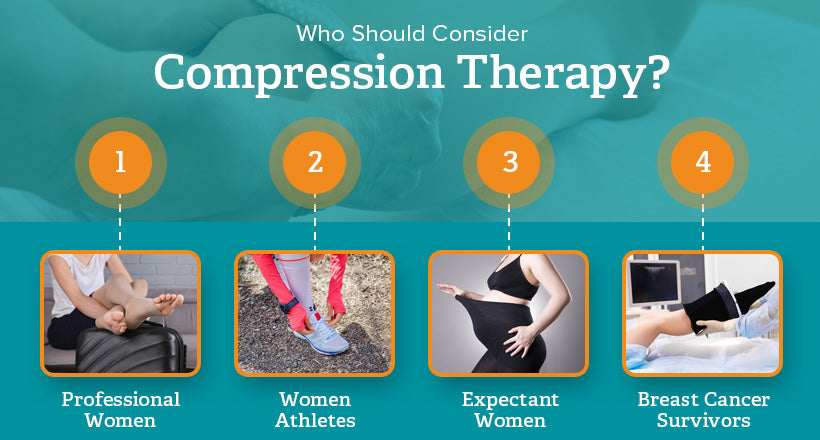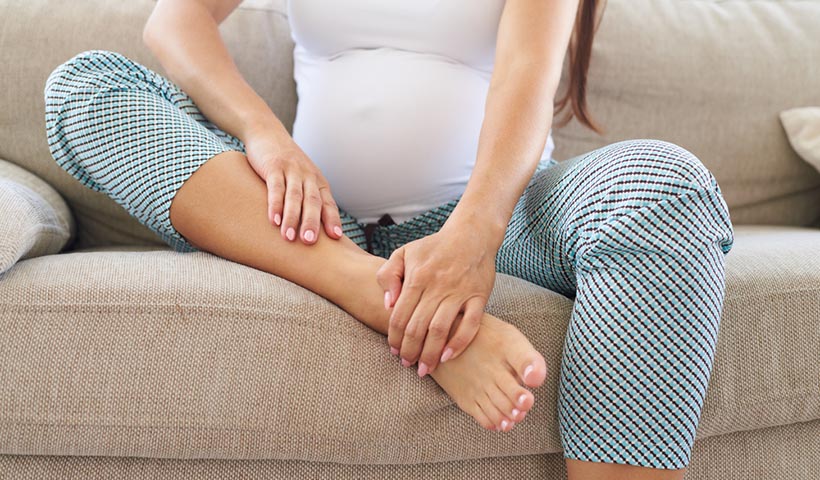
The Many Ways Compression Therapy Positively Impacts Women’s Health
Amidst the many other health issues that women face—from family planning to osteoporosis—circulation rarely tops the list. However, women’s circulation can be negatively affected by physical, environmental and social factors, even though women might not realize it until their symptoms have progressed quite far.
Below, we delve into the circulatory differences between women and men and how this impacts women’s blood flow, body temperature and more. Then, we discuss four particular groups of women who can especially benefit from compression therapy for circulation: professional workers, athletes, expectant mothers and breast cancer survivors.
Circulatory Differences Between Men and Women
The structure and placement of the circulatory system is virtually identical in men and women, but there are some critical differences that affect women’s circulation. On average, women have smaller bodies and lower metabolic rates than men, which can contribute to heat loss. Women have a higher surface area-to-volume ratio than men—meaning that a woman has more exposed skin than a man of the same size—which can further contribute to heat loss and slows circulation.
Women also tend to have more body fat than men (on average), and the fat is distributed in different locations throughout their bodies. Their bodies are also more sensitive to drops in temperature and will more quickly divert blood back to the core by constricting blood vessels in the extremities. Combined with the body fat distribution, this diversion of blood helps to keep a potential fetus warm. However, it also makes women more susceptible to a decrease in temperature, causing them to get colder faster.
Hormonal changes can also affect women’s circulation and body temperatures. Perhaps the most obvious one is menopause-related hot flashes. The exact cause of hot flashes isn’t known, but they’re likely related to the changes in reproductive hormones that come with menopause as well as changes to the hypothalamus (aka the body’s thermostat), which becomes more sensitive to slight changes in body temperature as women age.

A woman’s menstrual cycle can also affect her circulation and body temperature. Your body temperature varies throughout your monthly cycle, as do your hormones. If you bleed heavily during your period, you may lose too much iron, a critical component of hemoglobin, the substance in red blood cells that carries oxygen from your lungs to transport it throughout your body. This dip in hemoglobin can result in anemia if it’s left untreated.
All these factors combine to make women susceptible to circulatory issues. For example, Raynaud’s disease usually affects women much more frequently than men. In Raynaud's disease, the capillaries severely constrict in response to cold, turning the fingers, toes and other body parts white or blue.
Even if women have perfectly healthy circulation, these circulatory differences can be exacerbated by environmental and social factors. For example, office air conditioners are often set on full blast to cater to men’s higher body temperatures. Men’s professional clothing is often warmer than women’s—long-sleeve shirts, full-length pants and jackets vs. sleeveless tops and knee-length skirts—which further contributes to women’s low body temperatures and impaired circulation.
Who Should Consider Compression Therapy?
While compression therapy can benefit many people of all genders, sizes and lifestyles, it’s especially helpful for certain groups of individuals who are prone to circulatory issues. Below, we discuss four categories of women who should seriously consider compression therapy: professionals, athletes, expectant mothers and breast cancer survivors.
Professional Women
If you work in an office, chances are you’re probably freezing. Many professional women leave a sweater or blanket at work and keep space heaters under their desks just to stay warm enough to function, while the men keep bumping the thermostat even lower. These cold temperatures combined with the sedentary nature of most professional jobs can seriously slow down professional women’s circulation.
Your blood vessels are already constricted in response to the cold, which slows down your circulation. Then, gravity pulls down on your blood, lymph and other fluids all day, further impeding circulation and leading to swelling. (And this isn’t all: Studies have shown that the temperature affects how both men and women perform on math and verbal tests, though the effects are more pronounced for women. So being cold could actually be decreasing your productivity at work!)

Wearing compression stockings to the office can help fight off sluggish circulation and increase feelings of warmth. Compression pantyhose are available in both sheer and opaque materials that go perfectly under a nice skirt or dress. Compression dress socks are also available in many designs, including solid colors and professional patterns such as argyle and stripes. If you want to know more about wearing compression garments to the office, check out our compression guide for professional women.
Women Athletes
Good circulation is especially important for women athletes, since circulation affects performance. In fact, many pro athletes—both male and female—already wear compression socks and sleeves during workouts, games and matches in order to further boost their circulation and fight swelling. Watch closely the next time you turn on a televised sporting match and you’ll be sure to spot some compression socks and sleeves on the sidelines.
Compression therapy isn’t just helpful during a workout or game though. It also supports recovery. Physical activity breaks your body down, which is why you feel tired, heavy and sore after a major workout. Sleep is super important to helping your body recover, but so is good circulation. Your blood carries oxygen and other critical nutrients, which helps your body rebuild and recover. Because compression socks support circulation and speed up blood flow, this means that your hurting muscles get the nutrients faster than they would otherwise.
These benefits are why major women athletes such as Megan Rapinoe of the U.S. Women’s Soccer Team swear by compression therapy for performance and recovery. The World Cup champion wears compression sleeves to help ease her tight calves after long games. She also likes to partake in compression therapy in a more unusual way: by getting in the pool. She told Well + Good that she loves the compression the water provides, especially for her lower body. Plus, moving around in the water stretches out her muscles, further aiding recovery.

Expectant Women
Your body goes through many changes during pregnancy, many of which can impact your circulation. For example, much of the weight during pregnancy comes not from the baby, but from all the extra fluid your body produces in order to cushion the fetus. For example, your body creates 50 percent more blood and your heart works 30 percent harder during pregnancy. If you already have any venous issues, a pregnancy will exacerbate them.
Being pregnant can affect circulation even in perfectly healthy women. All that extra fluid often leads to swelling, and it can also put excess pressure on your blood vessels, which further slows your circulation. Swelling can happen at any time, but usually starts around month five and gets worse in the last trimester.
The baby itself also puts pressure on your veins as it grows, which can impede blood flow to the legs and back. The inferior vena cava (IVC) is particularly vulnerable during pregnancy. This major vein carries deoxygenated blood from the lower and middle body into the right atrium of the heart so it can be reoxygenated. Doctors advise that women should not lie on their backs during the later stages of their pregnancy in order to avoid compressing the inferior vena cava.
Thankfully, compression therapy can help ease both swelling and poor circulation in pregnant women. If you put compression stockings on first thing in the morning, before you start to swell, the tight fabric will force the excess to dissipate rather than collecting in your lower body. The compression stockings also put just the right amount of pressure on your veins, encouraging the blood to return to the core instead of lingering in your feet and calves. In turn, this can help prevent or minimize the appearance of pregnancy-induced spider and varicose veins.

Maternity pantyhose are especially popular among pregnant women since these tights provide light compression for the belly as well as the legs. However, pregnant women can wear any other style of compression gear, including knee-high socks and thigh-high stockings. If you just want compression for your stomach, you can also get a maternity compression band that wraps around your stomach for support. Make sure to talk to your doctor before wearing any compression gear during your pregnancy, just in case.
Breast Cancer Survivors
A clear substance that carries white blood cells to help fight infections and other diseases, lymph is critical to getting and staying healthy while you are sick. Lymphedema occurs when the lymph system malfunctions or becomes blocked, resulting in excess fluid collection and swelling (edema).
Treating cancer–breast or otherwise–can cause lymphedema in several ways. To slow or stop the spread of cancer, lymph nodes may be removed, which can cause the lymph system to malfunction or become blocked. If the radiation destroys nearby lymphatic tissue in addition to cancerous cells, chemotherapy can also cause the lymphatic system to become blocked. Because cancer treatment weakens your immune system, it also makes you more susceptible to infections that could potentially interfere with the flow of lymph. Finally, the tumor itself can cause lymphedema if it’s blocking part of the lymph system.
Because of all these factors, lymphedema is a relatively common side effect of breast cancer treatment. Lymphedema may be temporary or chronic, and it may appear directly after treatment or months (or years) later. Temporary lymphedema usually happens right after surgery or chemo and goes away on its own in about a month. Chronic lymphedema develops slowly over time, and the earlier you catch it and begin treatment, the easier it will be to manage your symptoms.
Alongside other treatments—such as elevating the limbs and maintaining a healthy weight—compression therapy can help you manage lymphedema after cancer treatment. The tight fabric of compression garments encourages the healthy flow of both blood and lymph to the affected body part. This discourages the lymph from collecting in one area, which is what causes the characteristic swelling of lymphedema. Compression socks also encourage healthy blood flow, which ensures that the affected areas are getting a steady supply of nutrients, which can speed the healing process.

If your lymphedema swelling fluctuates a lot, you might want to consider compression wraps instead of or in addition to compression sleeves. Compression wraps allow you to customize the size and are easier to put on by yourself if you have limited mobility, which may be the case after surgery.
Both men and women can benefit from compression therapy, and it can especially help women address some of the common circulatory issues that they face. Whether you’re a professional executive who freezes in her office, an athlete hampered by sore muscles, a mother-to-be or a breast cancer survivor on the road to recovery, talk to your doctor to see if compression therapy can help ease your symptoms and boost your performance. And if you need help picking out compression gear for the first time, our customer service team is always happy to help.
Kaki Zell - Vice President of Sales, Marketing, eCommerce at Legs-4-Life LLC Kaki holds a Bachelor of Science degree in Business Administration and Management from Virginia Polytechnic Institute and State University. She’s been working in the medical device industry for over 11 years and currently serves on the Board of Directors for the Greensboro Science Center.
Written October 2019 | Page Last Updated December 2021
Advances in Physiology Education. “Sex and the Cardiovascular System” https://journals.physiology.org/doi/full/10.1152/advan.00099.2006
